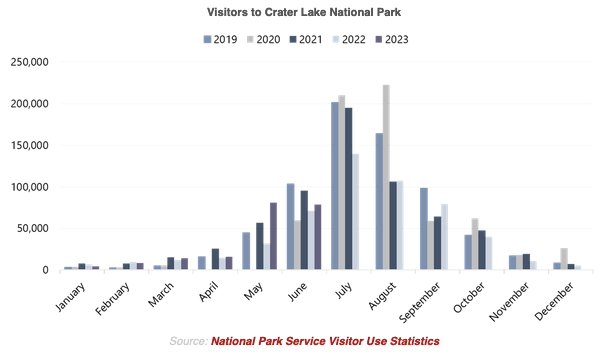Central Oregon, located east of the Cascade Mountains, is a popular drive-to destination comprising twelve cities. It attracts millions of visitors annually with its natural beauty and diverse landscape. However, the COVID-19 pandemic has greatly affected the travel industry, causing notable changes in hotels, businesses, and attractions across Central Oregon.
Central Oregon is a drive-to destination market situated east of the Cascade Mountain range. Home to twelve cities, this region of Oregon benefits as a popular leisure destination for travelers from throughout the Pacific Northwest. Surrounded by a diverse natural landscape, Central Oregon welcomes nearly four million overnight visitors per year looking to take advantage of all the area has to offer. In recent years, cities throughout the region have seen significant changes in the travel industry as hotels, businesses, and attractions have weathered the impacts of the COVID-19 pandemic.
Pre-Pandemic Trends
Overnight visitors to Central Oregon prior to the onset of the COVID-19 pandemic grew by approximately 7% from 2016 through 2019. As a result of this increase in visitation to the area, hotels throughout the region experienced a significant boost in occupancy and ADR, represented by increases in transient room tax levels during this period.

Growth during this time was primarily attributed to increased tourism as a result of Central Oregon’s prolific outdoor recreation. Approximately 60% of visitors traveled to the region to participate in outdoor activities in 2019. Additionally, development in the region’s healthcare sector, expansion of higher-education facilities, and growth in population contributed significantly to travel into Bend and Redmond, the largest cities in the region.
Normalization of the Market
Significant increases in leisure demand were registered in the Central Oregon market during the spring of 2021. This trend is illustrated by the number of visitors to Crater Lake National Park, one of the many outdoor recreation draws of the region. Growth continued through summer months. However, similar to the impact of the wildfires in 2020, visitation declined significantly in October 2021 as several of the largest wildfires in the state burned over 800,000 acres.

Transient tax revenue growth resumed by November 2021 and continued to increase through October 2022. However, beginning in May 2022, occupancy began to decline. At this time, pent-up leisure demand began to somewhat subside as travelers opted for alternate travel destinations following years of travel restrictions. Any revenue growth that occurred from May to October 2022 was largely driven by increases in guestroom rates. By the end of 2022, all metrics were trending downward. These trends have continued through May 2023.
As pent-up demand in Central Oregon has continued to dissipate and, in some cases, fall below pre-pandemic levels, visitor and economic development bureaus throughout the region have begun to focus on efforts to boost travel demand by increasing marketing spending and efforts. This includes leisure developments that supplement outdoor recreation attractions like Mt. Bachelor, Crater Lake National Park, and Hoodoo Butte. Most notably, Central Oregon’s food scene is gaining popularity. The Bend Ale Trail, the High Desert Food Trail, and nearly 40 breweries between Bend and Redmond are a large draw year-round. Bend and Redmond are also home to the Hayden Homes Amphitheater and the Deschutes County Fair & Expo Center, respectively. Both venues are significant draws for the region, with these venues hosting over 400 events total annually.

Market Outlook
Despite the normalization of demand in Central Oregon, visitors will continue to be attracted to the area’s extensive outdoor recreation activities and other leisure demand drivers, including the special events and concerts and the food and beverage attractions. With an anticipated expansion of the Deschutes County Fair & Expo Center, officials in the region anticipate demand levels to further increase in the next several years. Moreover, the ongoing improvement of the Hayden Homes Amphitheater and the strength of the concert lineup driven by its partnership with Live Nation bode well for the region.
For more information, please contact Breanna Smith or Hannah Homack with the HVS Portland office.
About Breanna S. Smith
Breanna Smith, MAI, a Managing Director with HVS Portland, gained revenue and sales management experience while working for Marriott International. In these roles, she made corporate sales for full-service Marriott-branded hotels across Texas, conducted strategic analyses and daily management of hotel transient guest performance data, and created strategies to maximize hotel revenue. Breanna earned a BSBA in Hospitality Management from the Daniels College of Business at the University of Denver. For more information, contact Breanna at bsmith@hvs.com or (303) 667-8860.
About Hannah Homack
Hannah Homack, a Project Manager with the HVS Portland Office, graduated from the University of Northern Colorado in May 2015. She holds a Bachelor of Arts in History Education. Hannah began a career in hospitality at the newly opened, dual-branded Hyatt Place/Hyatt House in Denver, Colorado as a front desk guest-experiences associate. This experience was followed by working as a Night-Audit Supervisor, Group Rooms Coordinator, and Revenue Analyst for the same property. Prior to joining HVS in May 2022, Hannah worked as a Corporate Revenue Manager for Azul Hospitality Group, managing several Hyatt, Wyndham, and Choice Hotels properties. Contact Hannah at 1 (971) 334-2799 or hhomack@hvs.com.
